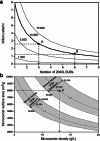Allogeneic cell therapy bioprocess economics and optimization: single-use cell expansion technologies
- PMID: 23893544
- PMCID: PMC4065358
- DOI: 10.1002/bit.25008
Allogeneic cell therapy bioprocess economics and optimization: single-use cell expansion technologies
Abstract
For allogeneic cell therapies to reach their therapeutic potential, challenges related to achieving scalable and robust manufacturing processes will need to be addressed. A particular challenge is producing lot-sizes capable of meeting commercial demands of up to 10(9) cells/dose for large patient numbers due to the current limitations of expansion technologies. This article describes the application of a decisional tool to identify the most cost-effective expansion technologies for different scales of production as well as current gaps in the technology capabilities for allogeneic cell therapy manufacture. The tool integrates bioprocess economics with optimization to assess the economic competitiveness of planar and microcarrier-based cell expansion technologies. Visualization methods were used to identify the production scales where planar technologies will cease to be cost-effective and where microcarrier-based bioreactors become the only option. The tool outputs also predict that for the industry to be sustainable for high demand scenarios, significant increases will likely be needed in the performance capabilities of microcarrier-based systems. These data are presented using a technology S-curve as well as windows of operation to identify the combination of cell productivities and scale of single-use bioreactors required to meet future lot sizes. The modeling insights can be used to identify where future R&D investment should be focused to improve the performance of the most promising technologies so that they become a robust and scalable option that enables the cell therapy industry reach commercially relevant lot sizes. The tool outputs can facilitate decision-making very early on in development and be used to predict, and better manage, the risk of process changes needed as products proceed through the development pathway.
Keywords: allogeneic cell therapy manufacture; bioprocess economics; cell factories; microcarriers; single-use cell expansion; stem cells.
© 2013 Wiley Periodicals, Inc.
Figures







Similar articles
-
Allogeneic cell therapy bioprocess economics and optimization: downstream processing decisions.Regen Med. 2015;10(5):591-609. doi: 10.2217/rme.15.29. Regen Med. 2015. PMID: 26237703
-
Platforms for Manufacturing Allogeneic, Autologous and iPSC Cell Therapy Products: An Industry Perspective.Adv Biochem Eng Biotechnol. 2018;165:323-350. doi: 10.1007/10_2017_14. Adv Biochem Eng Biotechnol. 2018. PMID: 28534167 Review.
-
Decisional tool for cost of goods analysis of bioartificial liver devices for routine clinical use.Cytotherapy. 2021 Aug;23(8):683-693. doi: 10.1016/j.jcyt.2021.04.006. Epub 2021 Jun 9. Cytotherapy. 2021. PMID: 34116945
-
Production of oncolytic adenovirus and human mesenchymal stem cells in a single-use, Vertical-Wheel bioreactor system: Impact of bioreactor design on performance of microcarrier-based cell culture processes.Biotechnol Prog. 2015 Nov-Dec;31(6):1600-12. doi: 10.1002/btpr.2158. Epub 2015 Sep 4. Biotechnol Prog. 2015. PMID: 26289142
-
Application of human mesenchymal and pluripotent stem cell microcarrier cultures in cellular therapy: achievements and future direction.Biotechnol Adv. 2013 Nov 15;31(7):1032-46. doi: 10.1016/j.biotechadv.2013.03.006. Epub 2013 Mar 24. Biotechnol Adv. 2013. PMID: 23531528 Review.
Cited by
-
Inertial-Based Filtration Method for Removal of Microcarriers from Mesenchymal Stem Cell Suspensions.Sci Rep. 2018 Aug 20;8(1):12481. doi: 10.1038/s41598-018-31019-y. Sci Rep. 2018. PMID: 30127526 Free PMC article.
-
Cultivation of mammalian cells using a single-use pneumatic bioreactor system.J Vis Exp. 2014 Oct 10;(92):e52008. doi: 10.3791/52008. J Vis Exp. 2014. PMID: 25349946 Free PMC article.
-
Bioprocessing of Human Mesenchymal Stem Cells: From Planar Culture to Microcarrier-Based Bioreactors.Bioengineering (Basel). 2021 Jul 7;8(7):96. doi: 10.3390/bioengineering8070096. Bioengineering (Basel). 2021. PMID: 34356203 Free PMC article. Review.
-
Identification and characterization of a large source of primary mesenchymal stem cells tightly adhered to bone surfaces of human vertebral body marrow cavities.Cytotherapy. 2020 Nov;22(11):617-628. doi: 10.1016/j.jcyt.2020.07.003. Epub 2020 Aug 30. Cytotherapy. 2020. PMID: 32873509 Free PMC article.
-
Pre-clinical evaluation of clinically relevant iPS cell derived neuroepithelial stem cells as an off-the-shelf cell therapy for spinal cord injury.Front Pharmacol. 2024 May 22;15:1390058. doi: 10.3389/fphar.2024.1390058. eCollection 2024. Front Pharmacol. 2024. PMID: 38841365 Free PMC article.
References
-
- Birch JR, Racher AJ. Antibody production. Adv Drug Deliver Rev. 2006;58:671–685. - PubMed
-
- Bowden MJ. Moore's Law and the technology S-curve. Curr Issues Technol Manage. 2004;8(1):1–4.
-
- Brandenberger R, Burger S, Campbell A, Fong T, Lapinskas E, Rowley JA. Cell therapy bioprocessing. BioProcess Int. 2011;9(Suppl. 1):30–37.
Publication types
MeSH terms
LinkOut - more resources
Full Text Sources
Other Literature Sources
Medical

